Dynamic Response of Bottom-Sitting Steel Shell Structures Subjected to Underwater Shock Waves
Abstract
1. Introduction
2. Materials
2.1. Explosive
2.2. Water
2.3. Air
2.4. Q690 Steel
3. Validation of the Numerical Simulation Method and Related Parameters
4. Discussion and Analysis of Results from Numerical Simulation
4.1. Numerical Model
4.2. Influence of Shock Wave Transmission Medium on the Dynamic Response of Semi-Spherical and Semi-Cylindrical Bottom-Sitting Steel Shells
4.3. Influence of Explosive Distance on the Dynamic Behaviors of Semi-Spherical and Semi-Cylindrical Bottom-Sitting Steel Shells
4.4. Influence of Explosive Equivalent on the Dynamic Behavior of Semi-Spherical and Semi-Cylindrical Bottom-Sitting Steel Shells
4.5. Influence of Hydrostatic Pressure on the Dynamic Response of Semi-Spherical and Semi-Cylindrical Bottom-Sitting Steel Shells
4.6. Influence of Shell Thickness on the Dynamic Response of Semi-Spherical and Semi-Cylindrical Bottom-Sitting Steel Shells
5. Conclusions
- (1)
- Deformation of the semi-spherical steel shell is mainly manifested in convex deformation above the location of the bottom constraints of the semi-spherical shell. Deformation of the semi-cylindrical steel shell mainly manifested in convex deformation at the bottom, concave deformation of the sidewalls at both ends, and concave deformation at the center.
- (2)
- Underwater shock waves induce significantly more severe deformation than air shock waves, with peak effective stresses in semi-spherical shells reaching 831.4 MPa (underwater) vs. 191 MPa (air) and vertical displacements differing by an order of magnitude. The semi-spherical geometry mitigates deformation through a curvature-induced ‘hoop effect’, reducing center displacement compared to semi-cylindrical shells under the same conditions.
- (3)
- Within 0–2.0092 MPa, hydrostatic pressure constrains horizontal convex deformation in both shell types via circumferential stress (hoop effect), but with different contrasting vertical responses. Semi-spherical shells: center vertical displacement decreases by 8% as hydrostatic pressure increases, due to enhanced vertical bearing capacity. Semi-cylindrical shells: inward concave deformation at the center increases by 26.34%, driven by weakened vertical stiffness under combined pressure and shock loads.
- (4)
- Increasing thickness from 0.025 m to 0.05 m reduces deformation across all load cases. For example, semi-cylindrical shells subjected to 300 kg of explosives show a displacement reduction from 0.2064 m to 0.0826 m, demonstrating their effectiveness in enhancing structural robustness. This provides a clear design guideline for optimizing shell thickness in underwater structures.
Author Contributions
Funding
Data Availability Statement
Acknowledgments
Conflicts of Interest
References
- Avachat, S.; Zhou, M. Response of submerged metallic sandwich structures to underwater impulsive loads. J. Mech. Mater. Struct. 2015, 10, 17–41. [Google Scholar] [CrossRef]
- Yang, G.; Fan, Y.; Wang, G.; Gao, Q.; Deng, K.; Wang, F. Numerical study on dynamic response of submerged tunnel subjected to underwater explosion. Soil. Dyn. Earthq. Eng. 2022, 156, 107216. [Google Scholar] [CrossRef]
- Liu, Z.; Zhou, X.; Xiao, L.; Li, X.; Lin, F. Dynamic response and damage characteristics of special blast-resistant door structure subjected to underwater explosion. Structures 2023, 57, 105262. [Google Scholar] [CrossRef]
- Hung, C.F.; Lin, B.J.; Hwang-Fuu, J.J.; Hsu, P.Y. Dynamic response of cylindrical shell structures subjected to underwater explosion. Ocean Eng. 2009, 36, 564–577. [Google Scholar] [CrossRef]
- Li, G.; Shi, D.; Chen, Y.; Yao, X.; Wang, Z.; Helal, W.M.K. A study on damage characteristics of double-layer cylindrical shells subjected to underwater contact explosion. Int. J. Impact Eng. 2023, 172, 104428. [Google Scholar] [CrossRef]
- Kristoffersen, M.; Minoretti, A.; Børvik, T. On the internal blast loading of submerged floating tunnels in concrete with circular and rectangular cross-sections. Eng. Fail. Anal. 2019, 103, 462–480. [Google Scholar] [CrossRef]
- Brett, J.M.; Yiannakopoulos, G.; Van der Schaaf, P.J. Time-resolved measurement of the deformation of submerged cylinders subjected to loading from a nearby explosion. Int. J. Impact Eng. 2000, 24, 875–890. [Google Scholar] [CrossRef]
- Brett, J.M.; Yiannakopolous, G. A study of explosive effects in close proximity to a submerged cylinder. Int. J. Impact Eng. 2008, 35, 206–225. [Google Scholar] [CrossRef]
- Huang, S.; Jin, Z.; Chen, Y. Underwater blast resistance of double cylindrical shells with circular tube stiffeners. Ocean Eng. 2021, 238, 109691. [Google Scholar] [CrossRef]
- Zhang, J.; Huang, Z.; Chen, Z.; Li, Y. Dynamic response of spherical shells subjected to the underwater impulse. Ocean Eng. 2023, 286, 115568. [Google Scholar] [CrossRef]
- Li, X.; Kurata, M.; Nakashima, M. Evaluating damage extent of fractured beams in steel moment-resisting frames using dynamic strain responses. Earthq. Eng. Struct. Dyn. 2015, 44, 563–581. [Google Scholar] [CrossRef]
- Razavi, M.; Hadidi, A.; Ashrafzadeh, F. Feature extraction based on dynamic response measurements for structural damage identification: A comparative study. J. Struct. Integr. Maint. 2024, 9, 2364125. [Google Scholar] [CrossRef]
- Danai, K.; Civjan, S.A.; Styckiewicz, M.M. Direct method of damage localization for civil structures via shape comparison of dynamic response measurements. Comput. Struct. 2012, 92, 297–307. [Google Scholar] [CrossRef]
- Kwon, Y.W.; Fox, P.K. Underwater shock response of a cylinder subjected to a side-on explosion. Comput. Struct. 1993, 48, 637–646. [Google Scholar] [CrossRef]
- Wu, W.; Liu, M.; Zhang, A.-M.; Liu, Y.-L. Fully coupled model for simulating highly nonlinear dynamic behaviors of a bubble near an elastic-plastic thin-walled plate. Phys. Rev. Fluids 2021, 6, 13605. [Google Scholar] [CrossRef]
- Nayak, S.; Lyngdoh, G.A.; Shukla, A.; Das, S. Predicting the near field underwater explosion response of coated composite cylinders using multiscale simulations, experiments, and machine learning. Compos. Struct. 2022, 283, 115157. [Google Scholar] [CrossRef]
- Gannon, L. Submerged aluminum cylinder response to close-proximity underwater explosions–a comparison of experiment and simulation. Int. J. Impact Eng. 2019, 133, 103339. [Google Scholar] [CrossRef]
- Praba, R.P.S.; Ramajeyathilagam, K. Numerical investigations on the large deformation behaviour of ring stiffened cylindrical shell subjected to underwater explosion. Appl. Ocean Res. 2020, 101, 102262. [Google Scholar] [CrossRef]
- Wu, W.; Zhang, A.M.; Liu, Y.-L.; Liu, M. Interaction between shock wave and a movable sphere with cavitation effects in shallow water. Phys. Fluids 2020, 32, 16103. [Google Scholar] [CrossRef]
- Yin, C.; Jin, Z.; Chen, Y.; Hua, H. Effects of sacrificial coatings on stiffened double cylindrical shells subjected to underwater blasts. Int. J. Impact Eng. 2020, 136, 103412. [Google Scholar] [CrossRef]
- Peng, Y.-X.; Zhang, A.-M.; Ming, F.-R. Numerical simulation of structural damage subjected to the near-field underwater explosion based on SPH and RKPM. Ocean Eng. 2021, 222, 108576. [Google Scholar] [CrossRef]
- Yang, G.; Wang, G.; Fan, Y.; Deng, K.; Lu, W.; Zhao, J. Dynamic response and performance of submarine tunnel subjected to surface explosions. Mar. Struct. 2021, 80, 103091. [Google Scholar] [CrossRef]
- Yang, G.; Wang, G.; Lu, W.; Yan, P.; Chen, M. Damage assessment and mitigation measures of underwater tunnel subjected to blast loads. Tunn. Undergr. Sp. Technol. 2019, 94, 103131. [Google Scholar] [CrossRef]
- Brochard, K.; Le Sourne, H.; Barras, G. Estimation of the response of a deeply immersed cylinder to the shock wave generated by an underwater explosion. Mar. Struct. 2020, 72, 102786. [Google Scholar] [CrossRef]
- Wierzbicki, T.; Fatt, M.S.H. Damage assessment of cylinders due to impact and explosive loading. Int. J. Impact Eng. 1993, 13, 215–241. [Google Scholar] [CrossRef]
- Benson, D.J. Computational methods in Lagrangian and Eulerian hydrocodes. Comput. Methods Appl. Mech. Eng. 1992, 99, 235–394. [Google Scholar] [CrossRef]
- Wu, W.; Liu, Y.-L.; Zhang, A.-M.; Liu, M. An h-adaptive local discontinuous Galerkin method for second order wave equation: Applications for the underwater explosion shock hydrodynamics. Ocean Eng. 2022, 264, 112526. [Google Scholar] [CrossRef]
- Mussa, M.H.; Mutalib, A.A.; Hamid, R.; Naidu, S.R.; Radzi, N.A.M.; Abedini, M. Assessment of damage to an underground box tunnel by a surface explosion. Tunn. Undergr. Sp. Technol. 2017, 66, 64–76. [Google Scholar] [CrossRef]
- Wu, W.; Liu, Y.-L.; Zhang, A.-M.; Liu, N.; Liu, L. Numerical investigation on underwater explosion cavitation characteristics near water wave. Ocean. Eng. 2020, 205, 107321. [Google Scholar] [CrossRef]
- Zhang, J.; Lin, Z.; Wang, F.; Zhao, T.; Zhu, Y. Ultimate strength of externally pressurised steel spheres containing through-thickness defects. Int. J. Press. Vessel. Pip. 2022, 199, 104750. [Google Scholar] [CrossRef]
- Zhang, J.; Zhang, M.; Tang, W.; Wang, W.; Wang, M. Buckling of spherical shells subjected to external pressure: A comparison of experimental and theoretical data. Thin-Walled Struct. 2017, 111, 58–64. [Google Scholar] [CrossRef]
- Stachiw, J.D. Ocean Engineering Studies: Pressure Hulls, Cellular Sandwich Construction; Naval Ocean Systems Center: San Diego, CA, USA, 1990; Volume 8. [Google Scholar]
- Valdez, B.; Schorr, M.; Bastidas, J.M. The natural gas industry: Equipment, materials, and corrosion. Corros. Rev. 2015, 33, 175–185. [Google Scholar] [CrossRef]
- Karamanos, S.A.A. Structural Mechanics and Design of Metal Pipes: A Systematic Approach for Onshore and Offshore Pipelines; Elsevier: Amsterdam, The Netherlands, 2022. [Google Scholar]
- Geyer, R.A. Submersibles and Their Use in Oceanography and Ocean Engineering; Elsevier: Amsterdam, The Netherlands, 2011; Volume 17. [Google Scholar]
- Meng, Q.; Zhang, K.; He, R.; Qu, Z. A review of thermal shock behavior of ceramics: Fundamental theory, experimental methods, and outlooks. Int. J. Appl. Ceram. Technol. 2024, 21, 3789–3811. [Google Scholar] [CrossRef]
- Lü, C.F.; Chen, W.Q.; Shao, J. Semi-analytical three-dimensional elasticity solutions for generally laminated composite plates. Eur. J. Mech. 2008, 27, 899–917. [Google Scholar] [CrossRef]
- Wang, H.M. Dynamic electromechanical behavior of a triple-layer piezoelectric composite cylinder with imperfect interfaces. Appl. Math. Model. 2011, 35, 1765–1781. [Google Scholar] [CrossRef]
- Gupta, S.; Matos, H.; LeBlanc, J.M.; Shukla, A. Shock initiated instabilities in underwater cylindrical structures. J. Mech. Phys. Solids 2016, 95, 188–212. [Google Scholar] [CrossRef]
- Yang, G.; Fan, Y.; Wang, G.; Cui, X.; Leng, Z.; Lu, W. Blast resistance of air-backed RC slab against underwater contact explosion. Def. Technol. 2023, 28, 236–250. [Google Scholar] [CrossRef]
- Xie, L.X.; Lu, W.B.; Zhang, Q.B.; Jiang, Q.H.; Chen, M.; Zhao, J. Analysis of damage mechanisms and optimization of cut blasting design under high in-situ stresses. Tunn. Undergr. Sp. Technol. 2017, 66, 19–33. [Google Scholar] [CrossRef]
- Yang, X.; Yang, H.; Zhang, S. Rate-dependent constitutive models of S690 high-strength structural steel. Constr. Build. Mater. 2019, 198, 597–607. [Google Scholar] [CrossRef]
- Cole, R.H.; Weller, R. Underwater Explosions; American Institute of Physics: College Park, MD, USA, 1948; Volume 1. [Google Scholar]
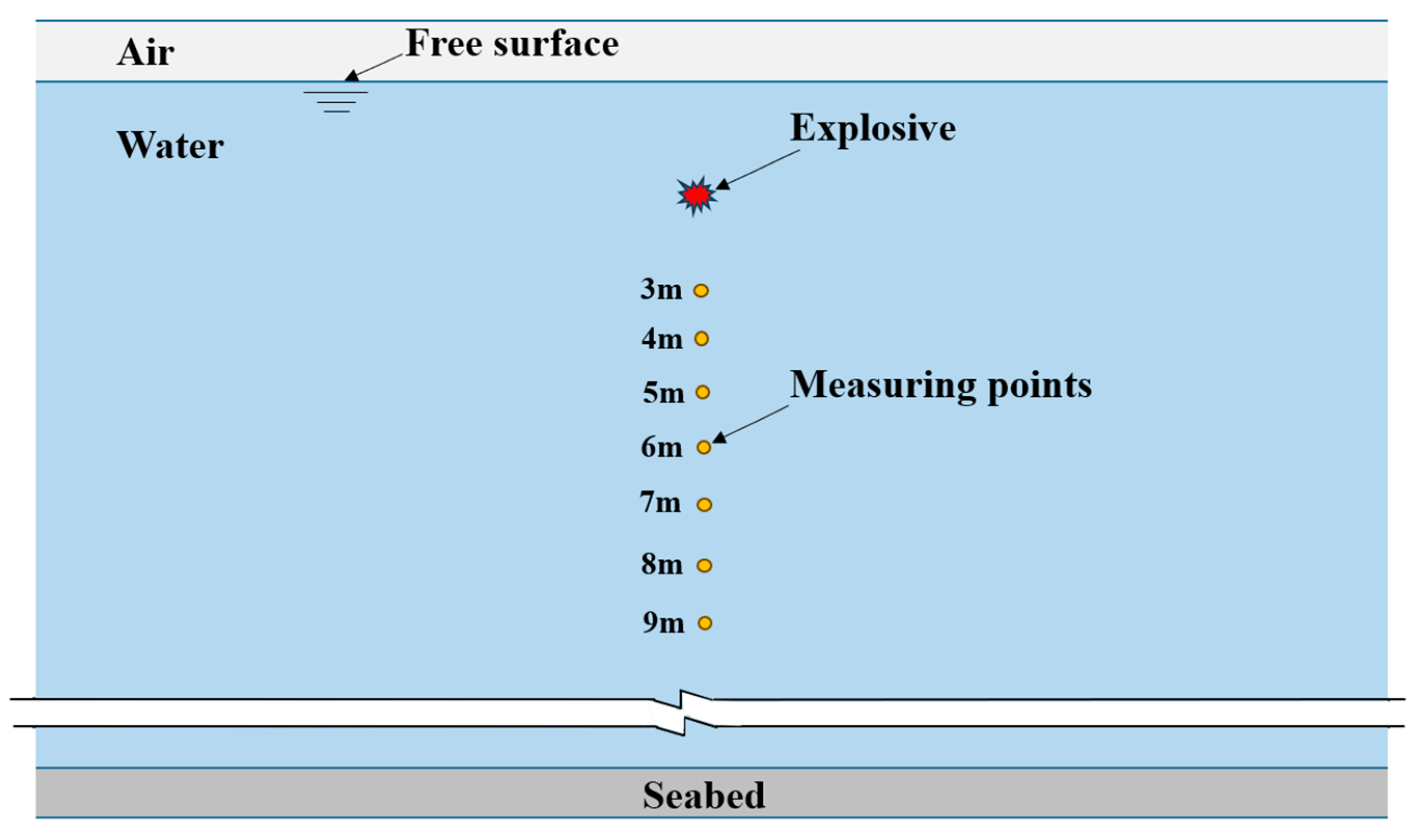


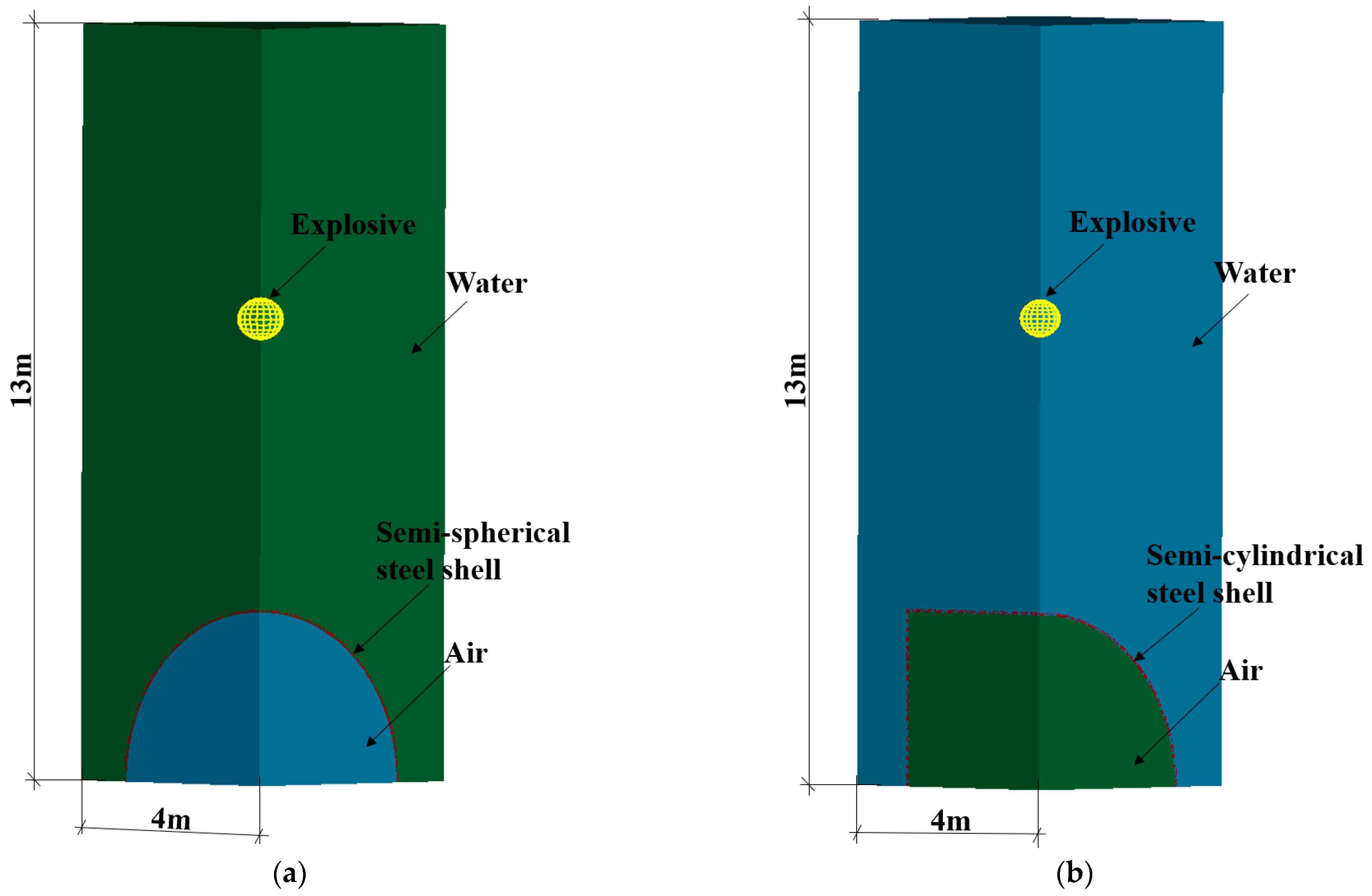



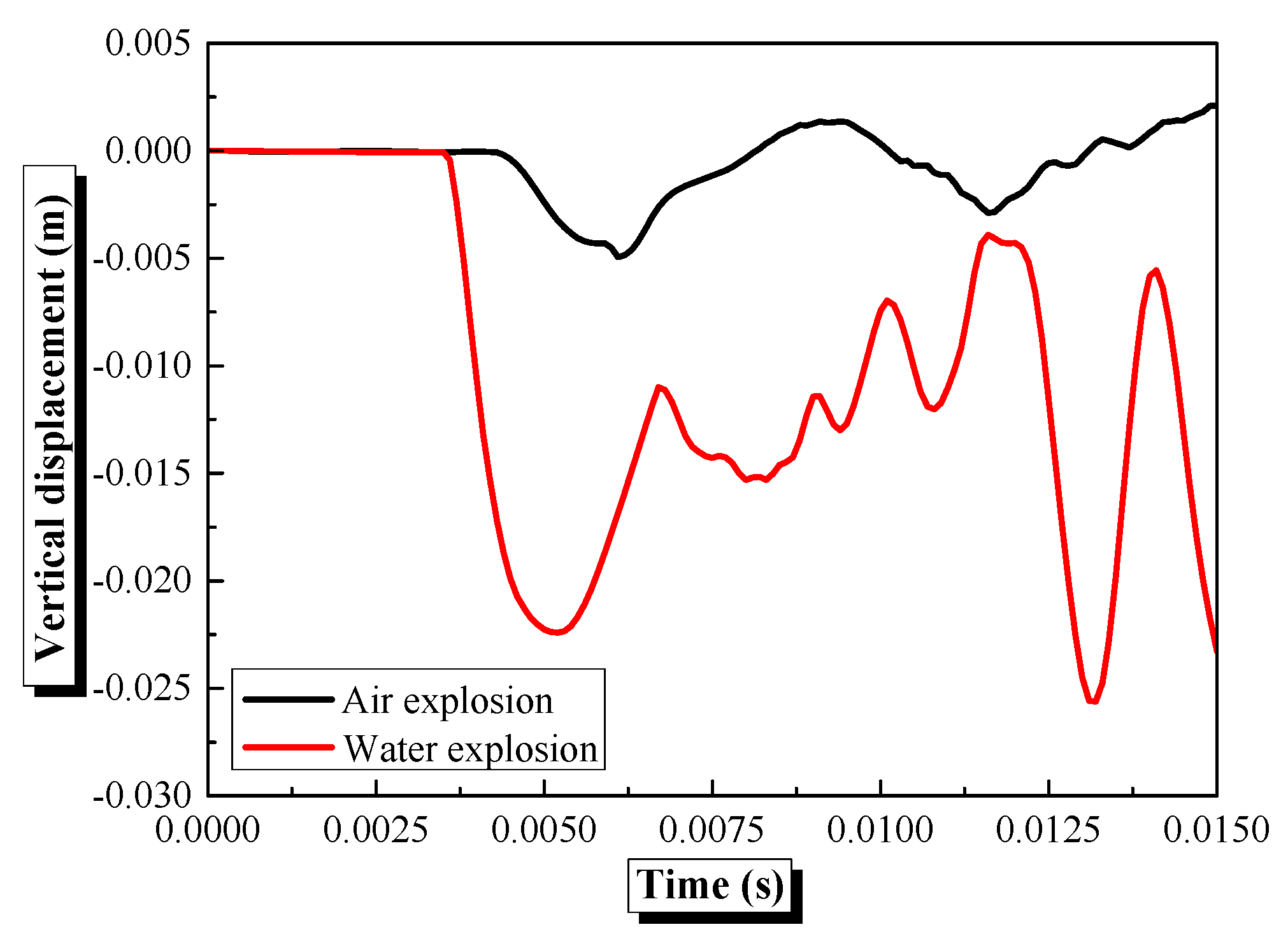
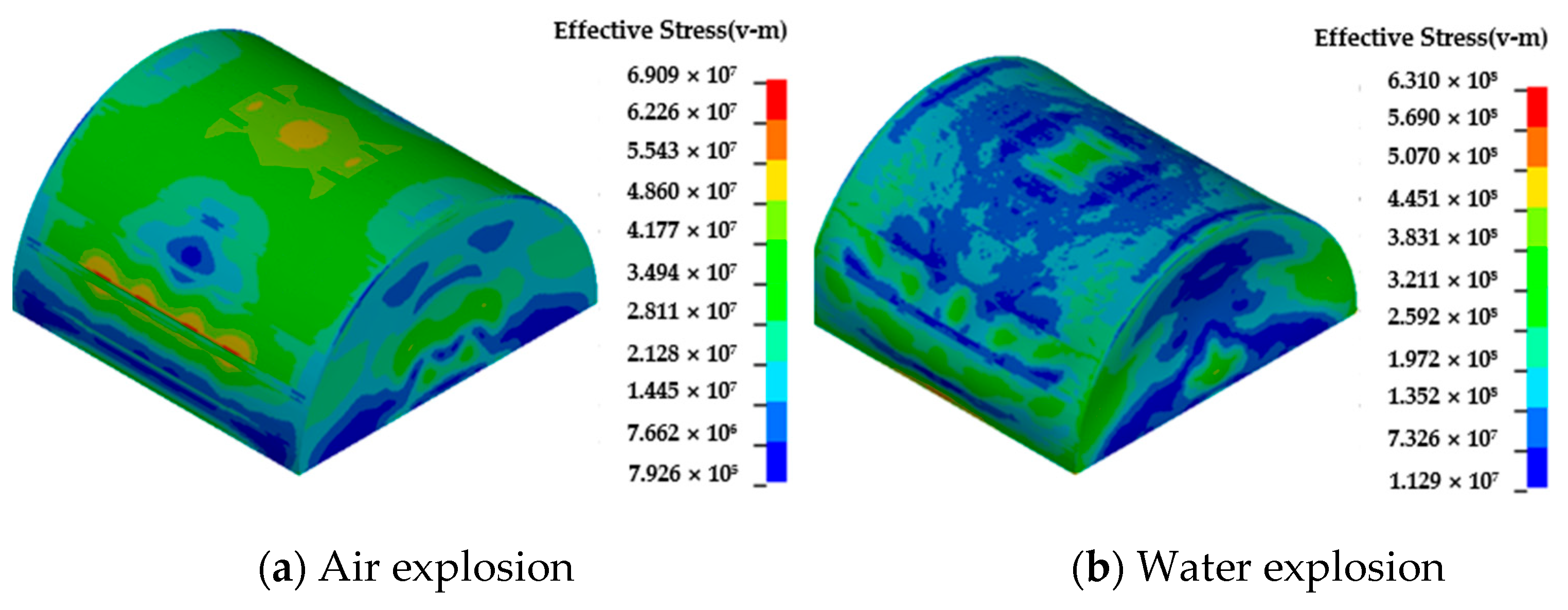
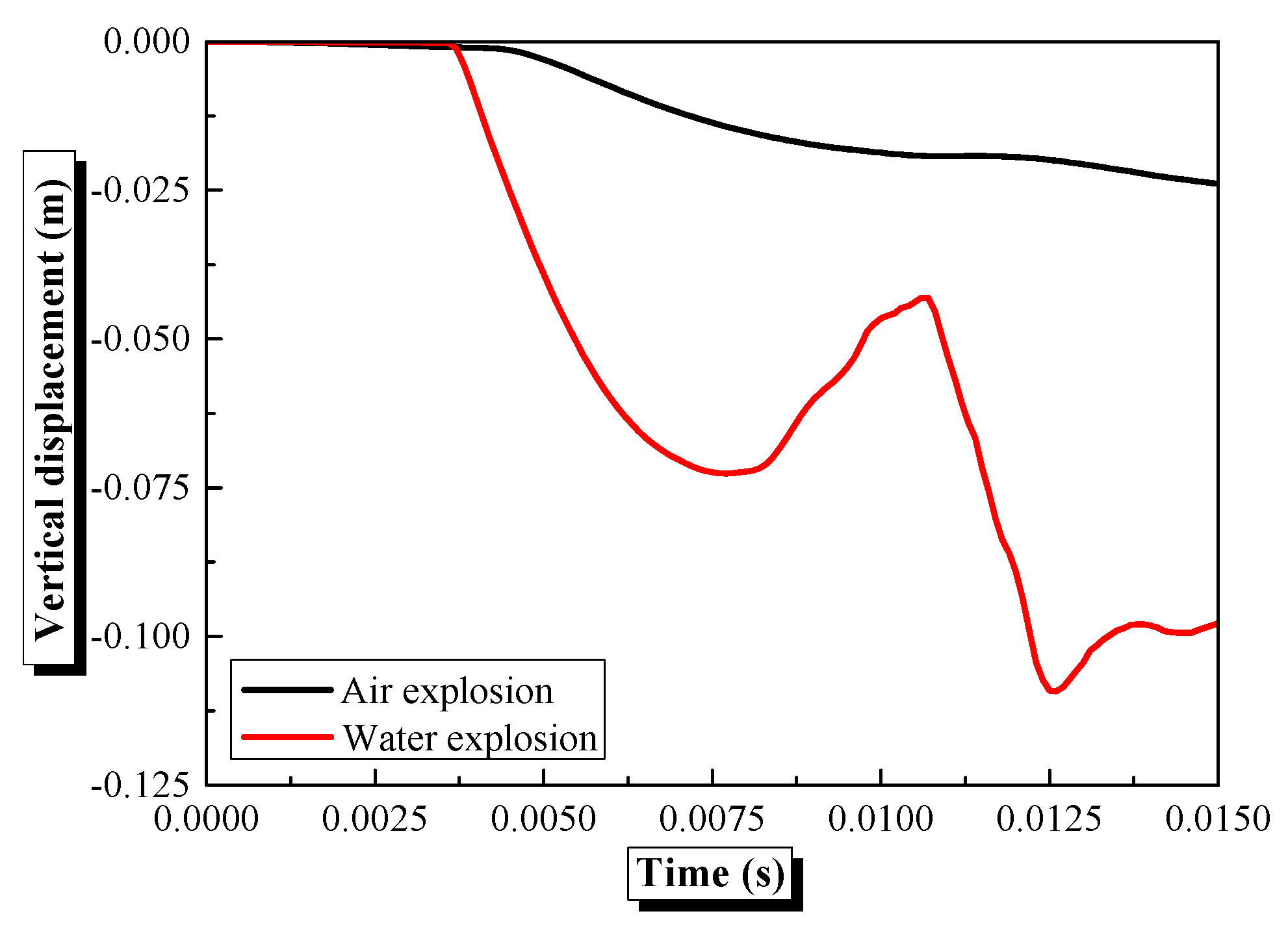
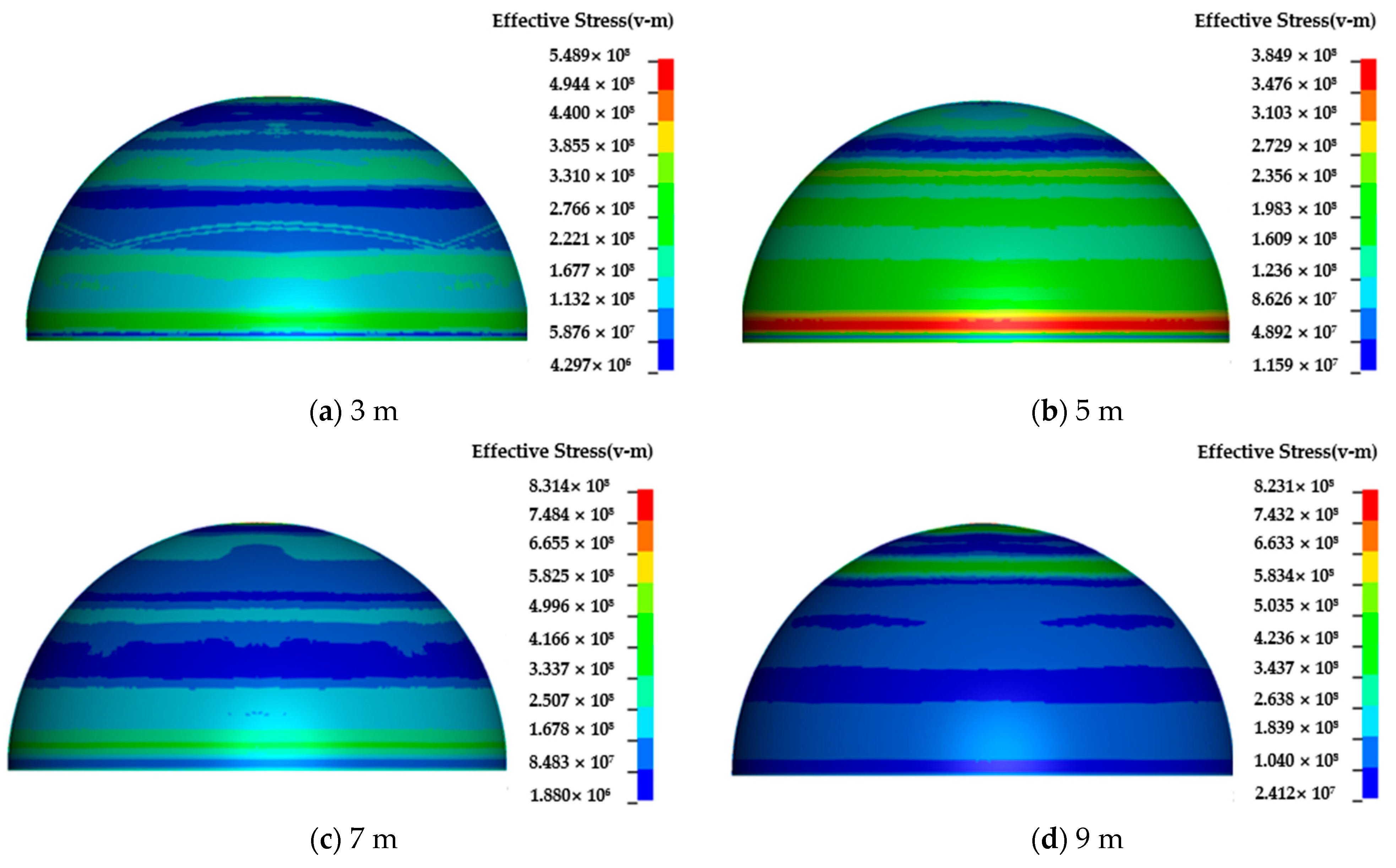
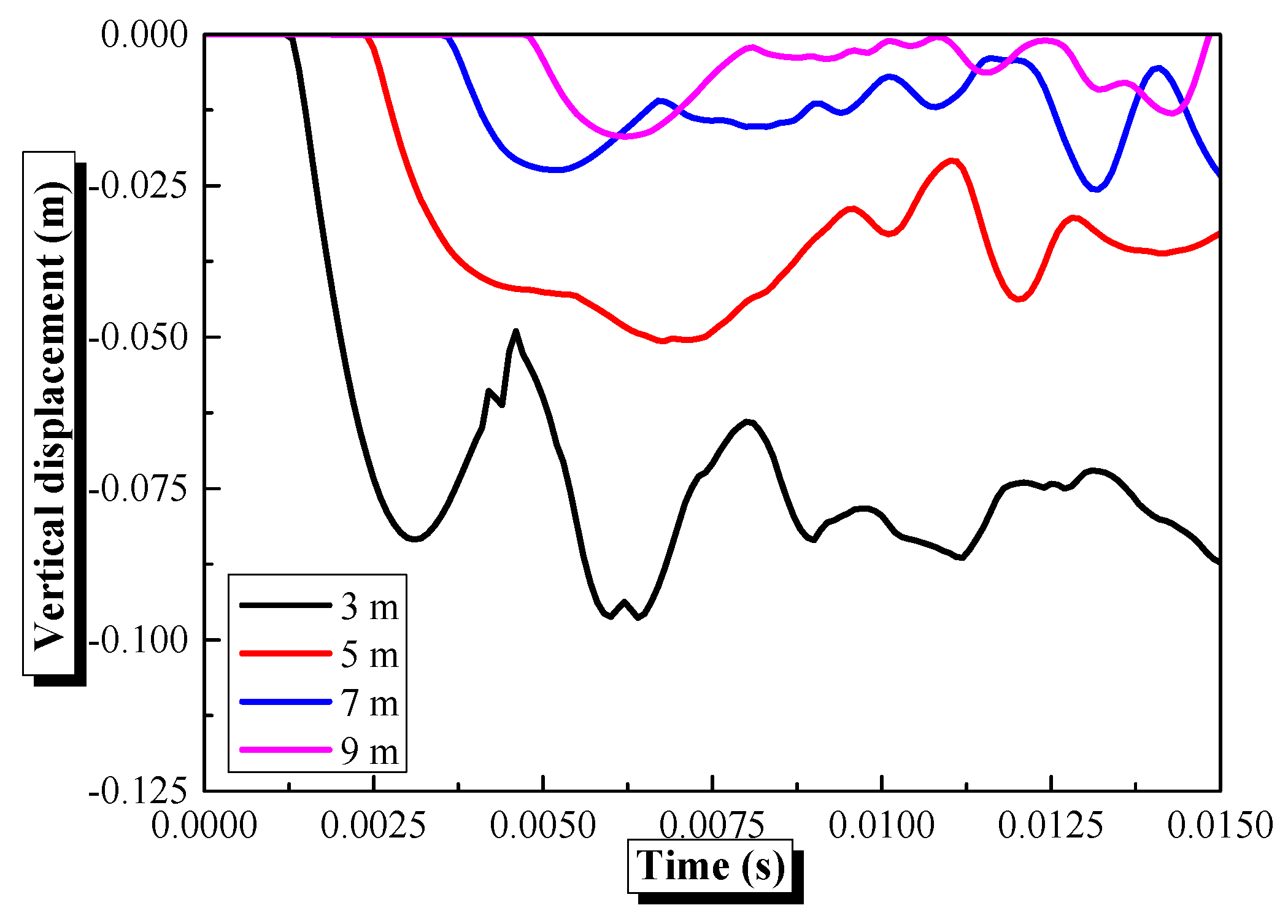
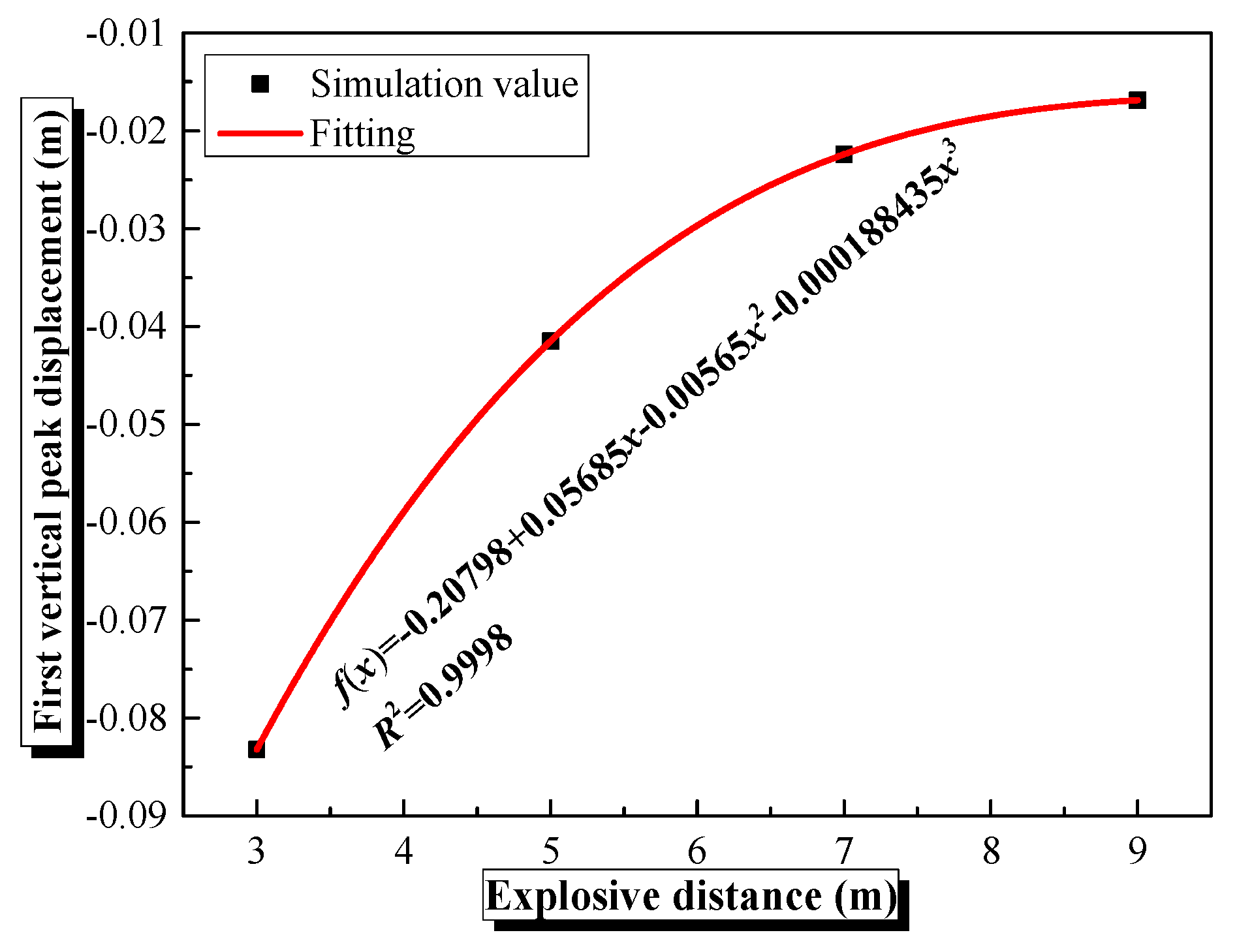

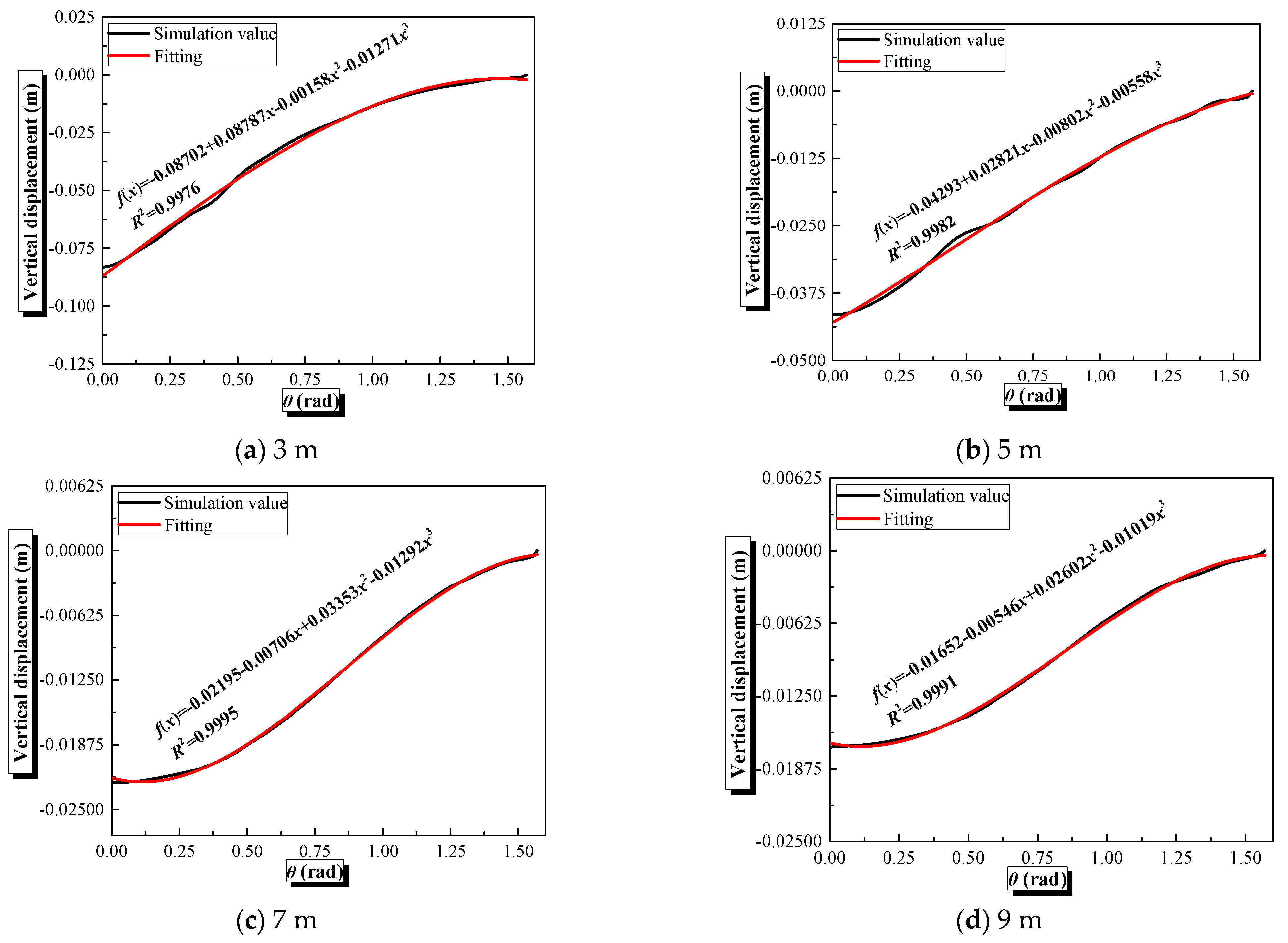
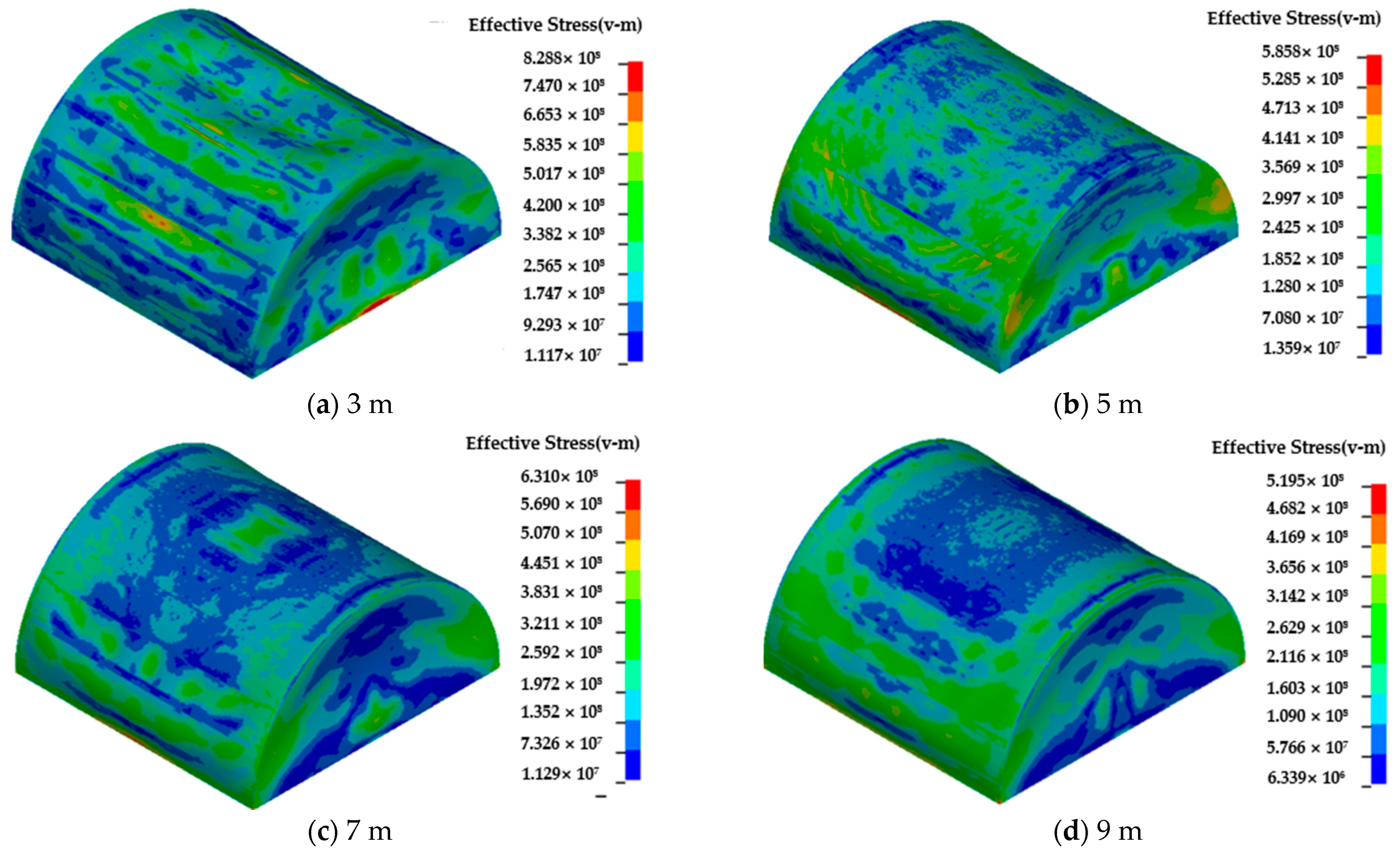
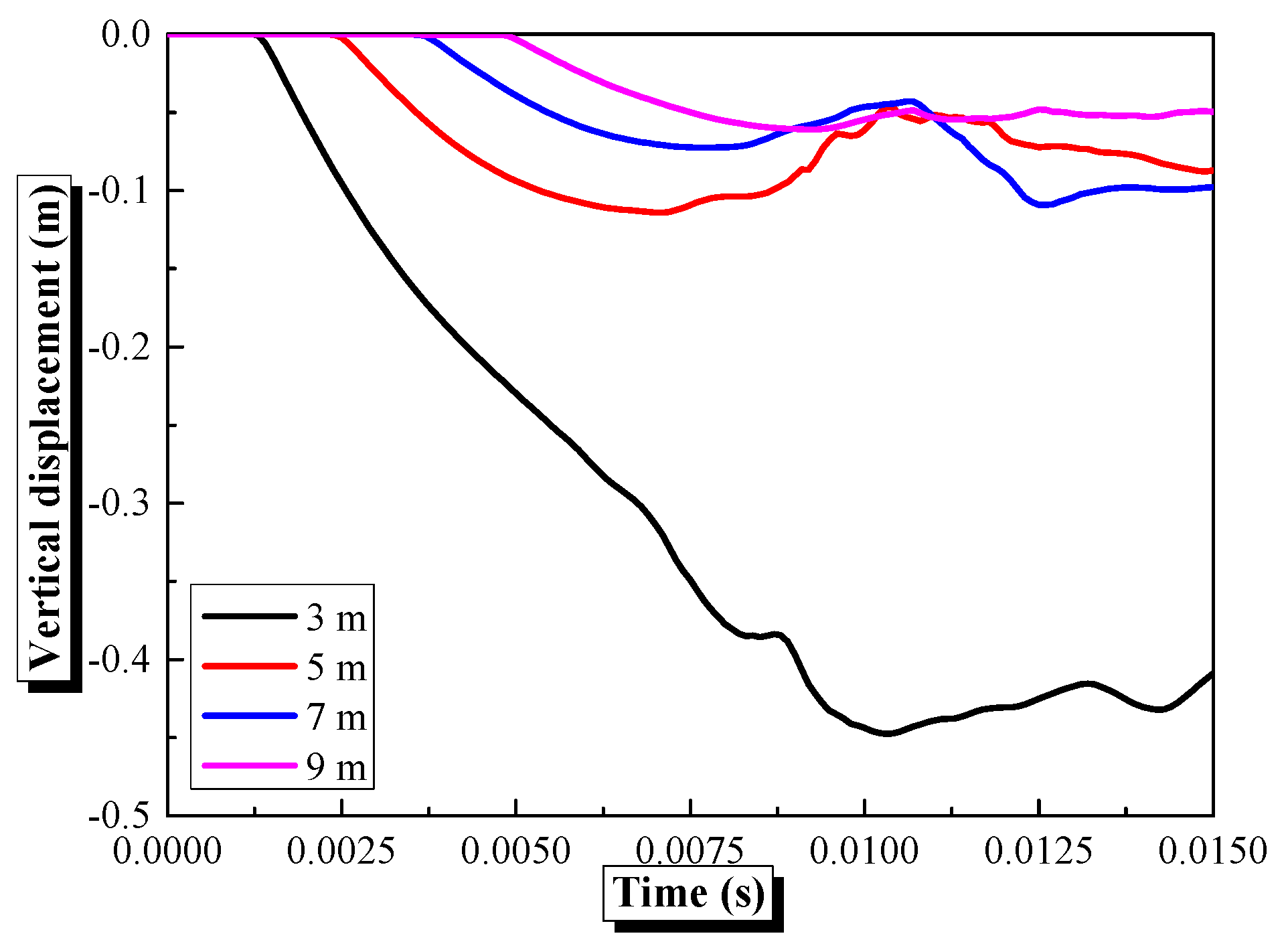

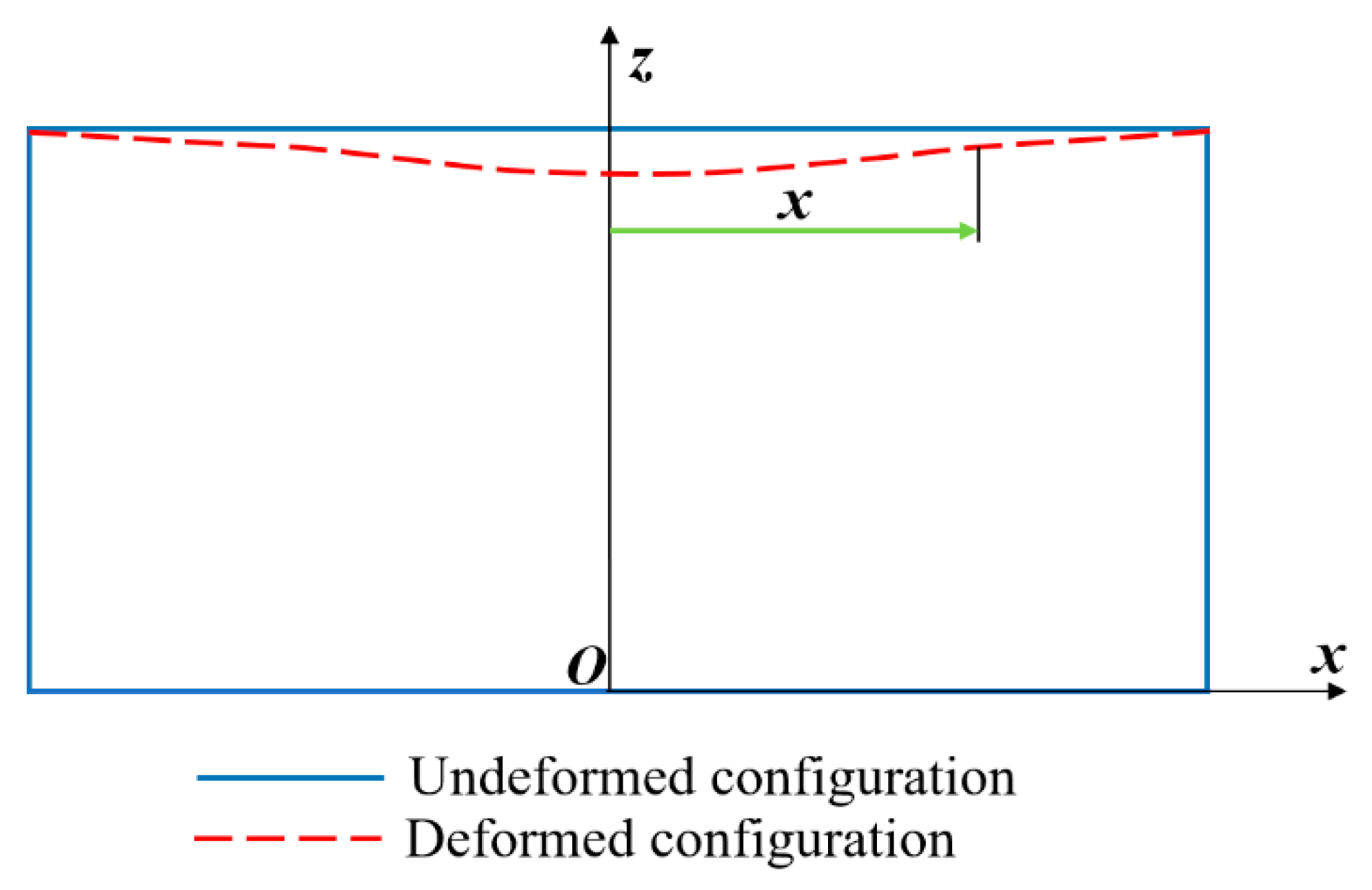
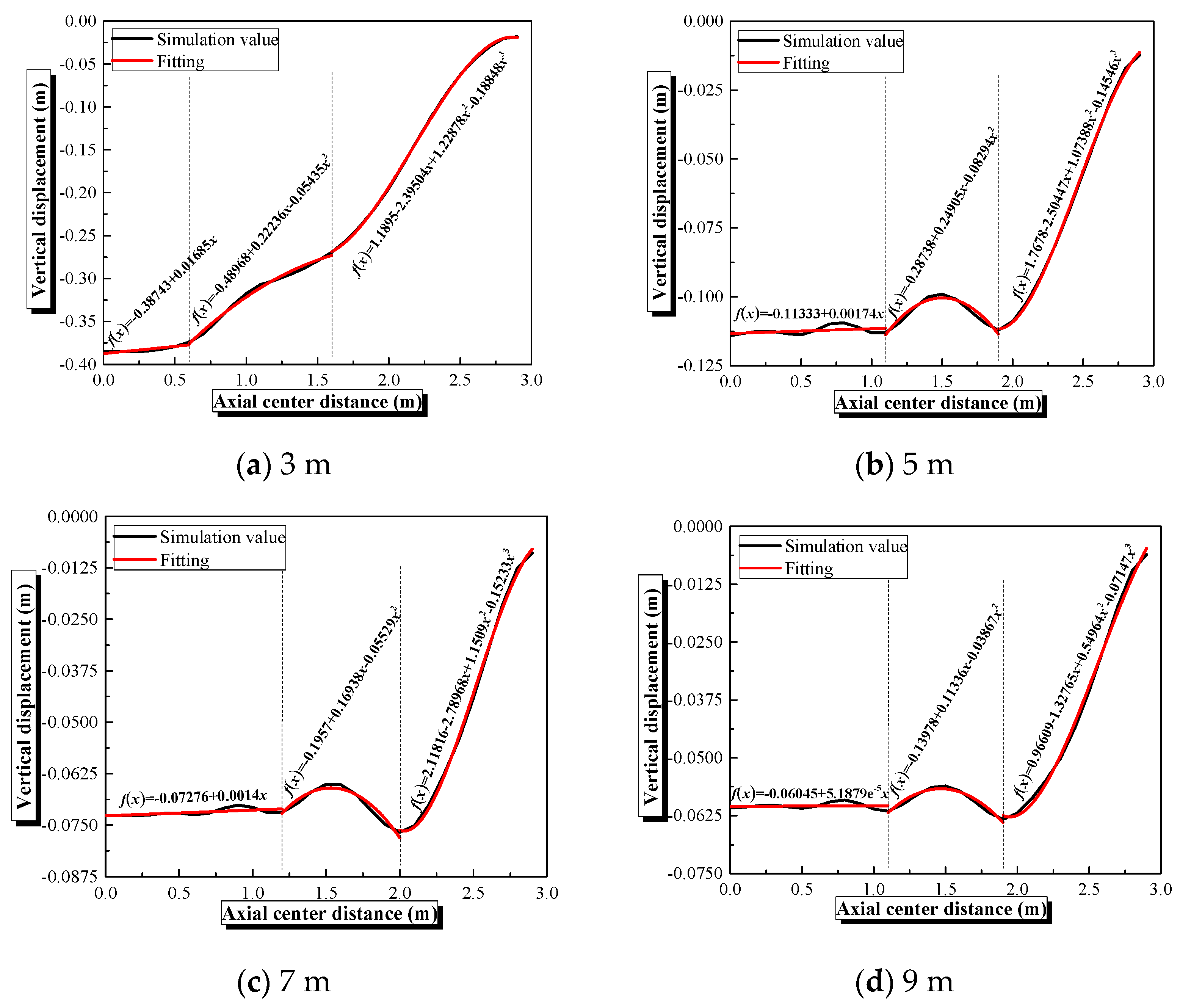
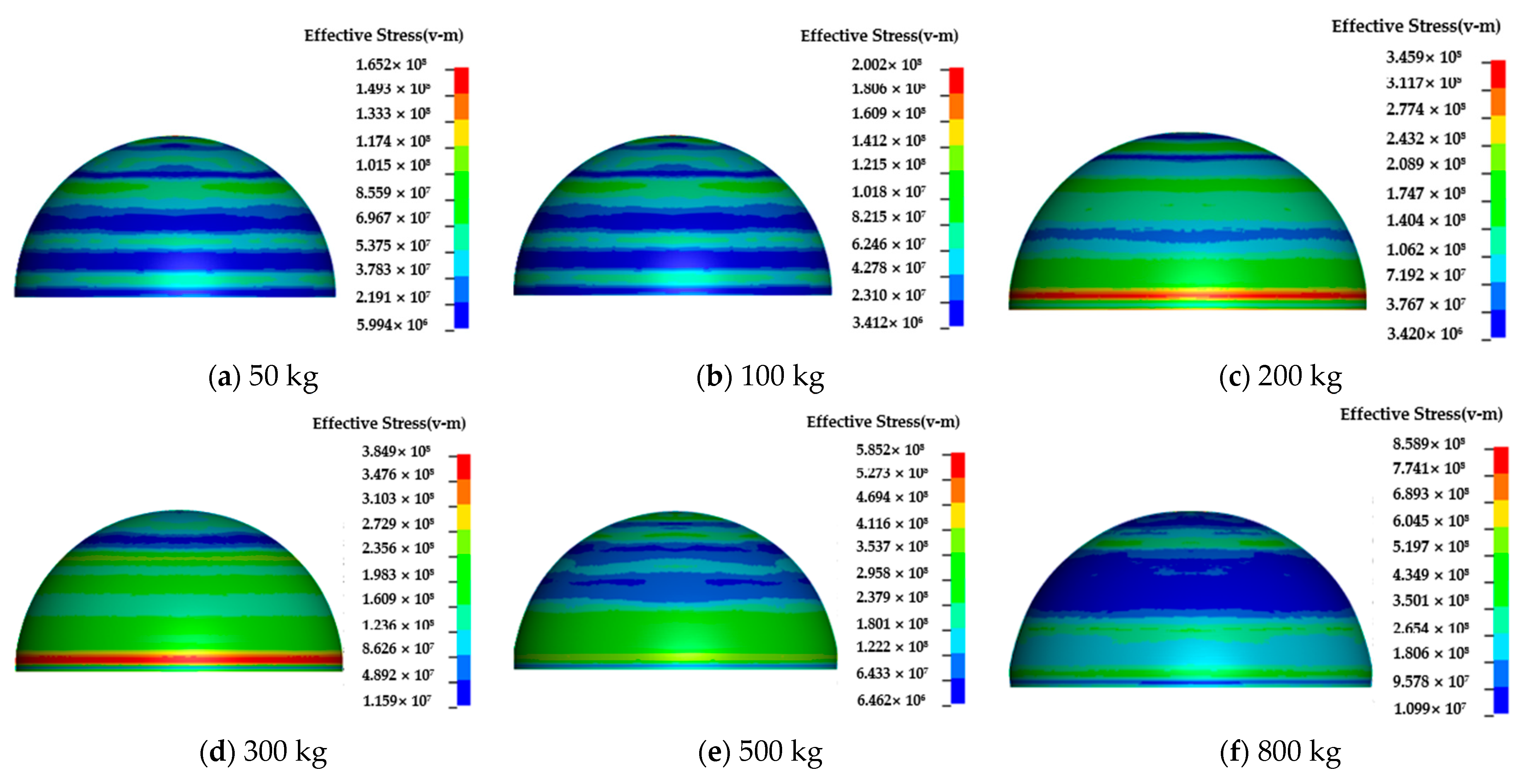


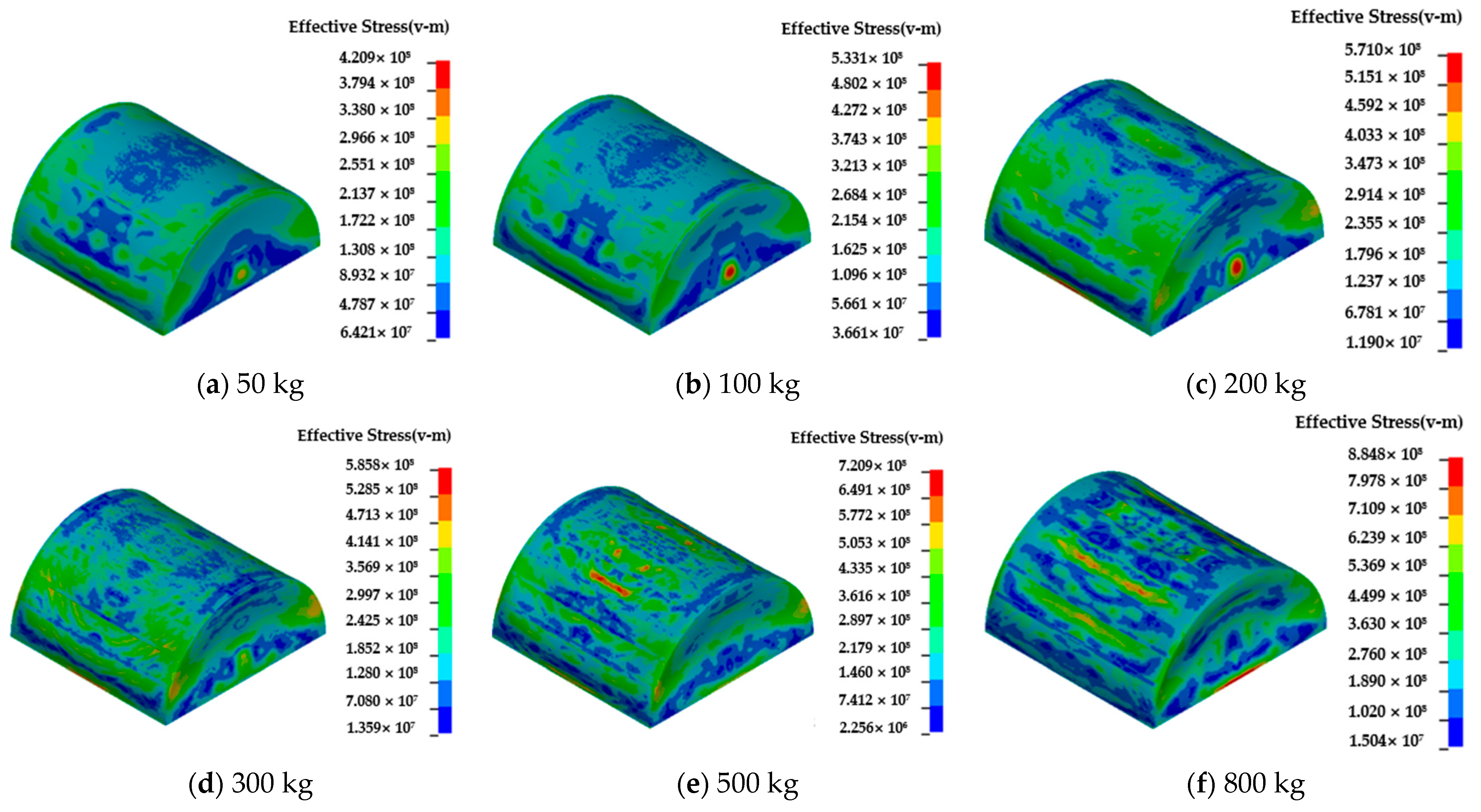
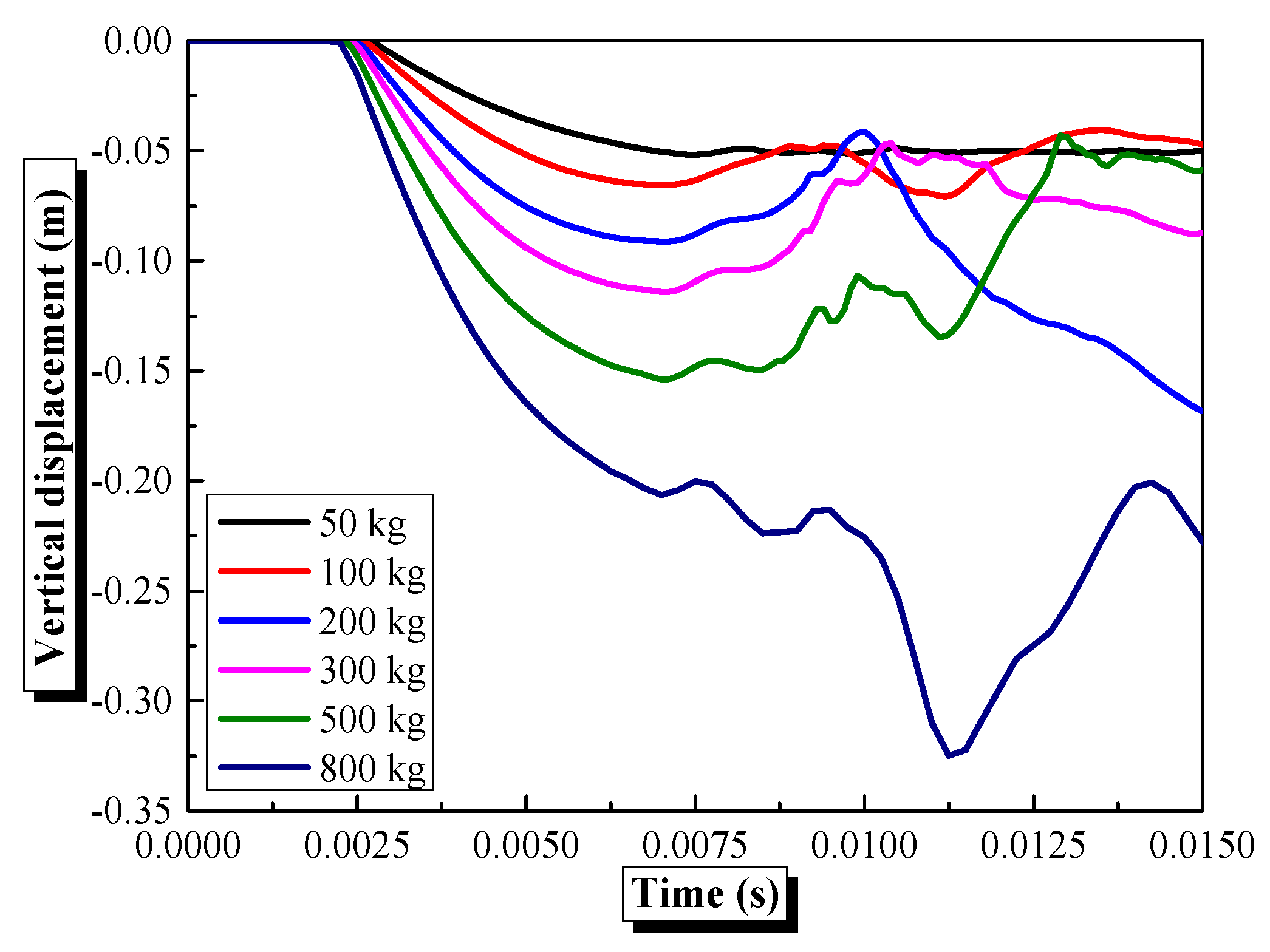
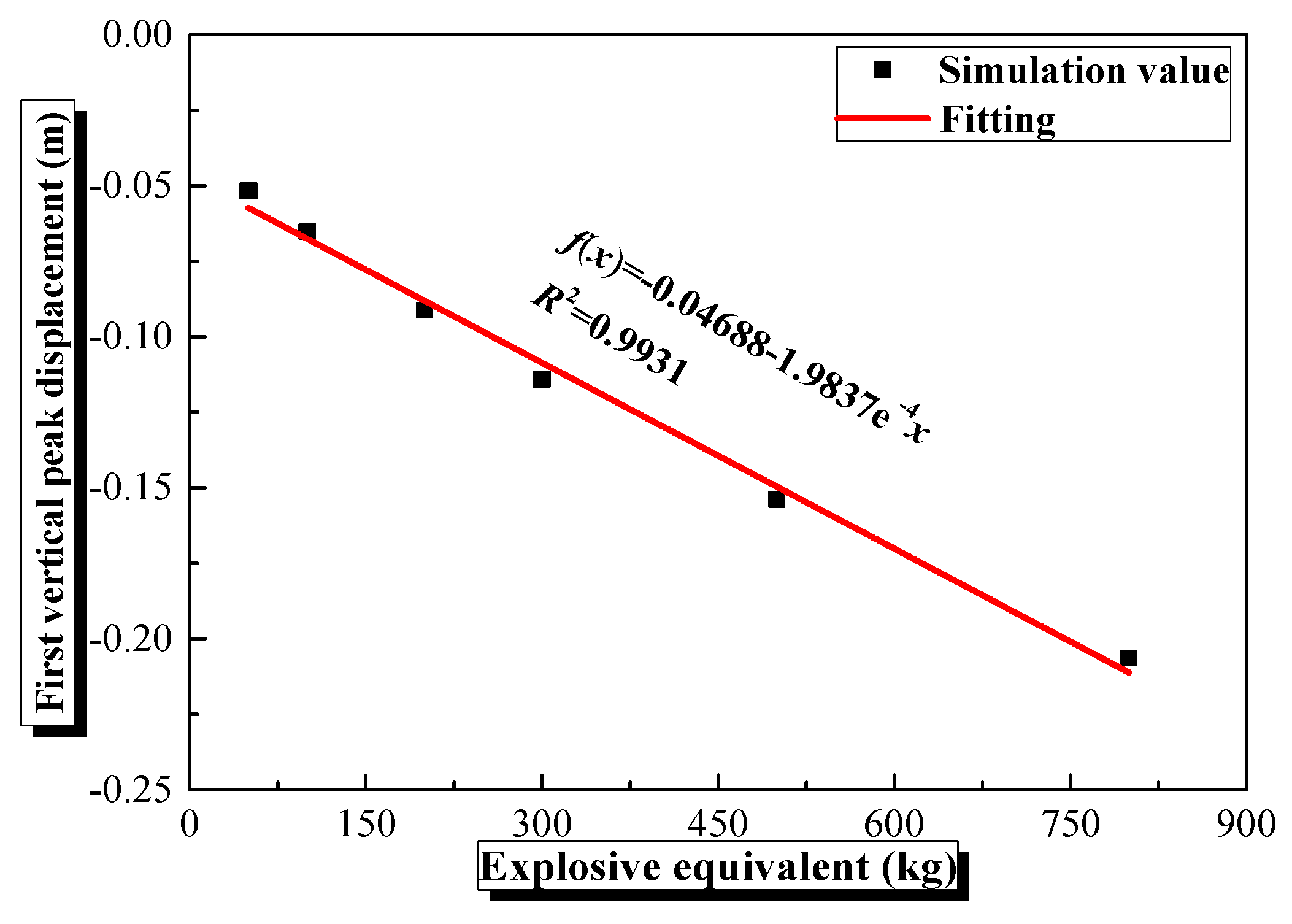
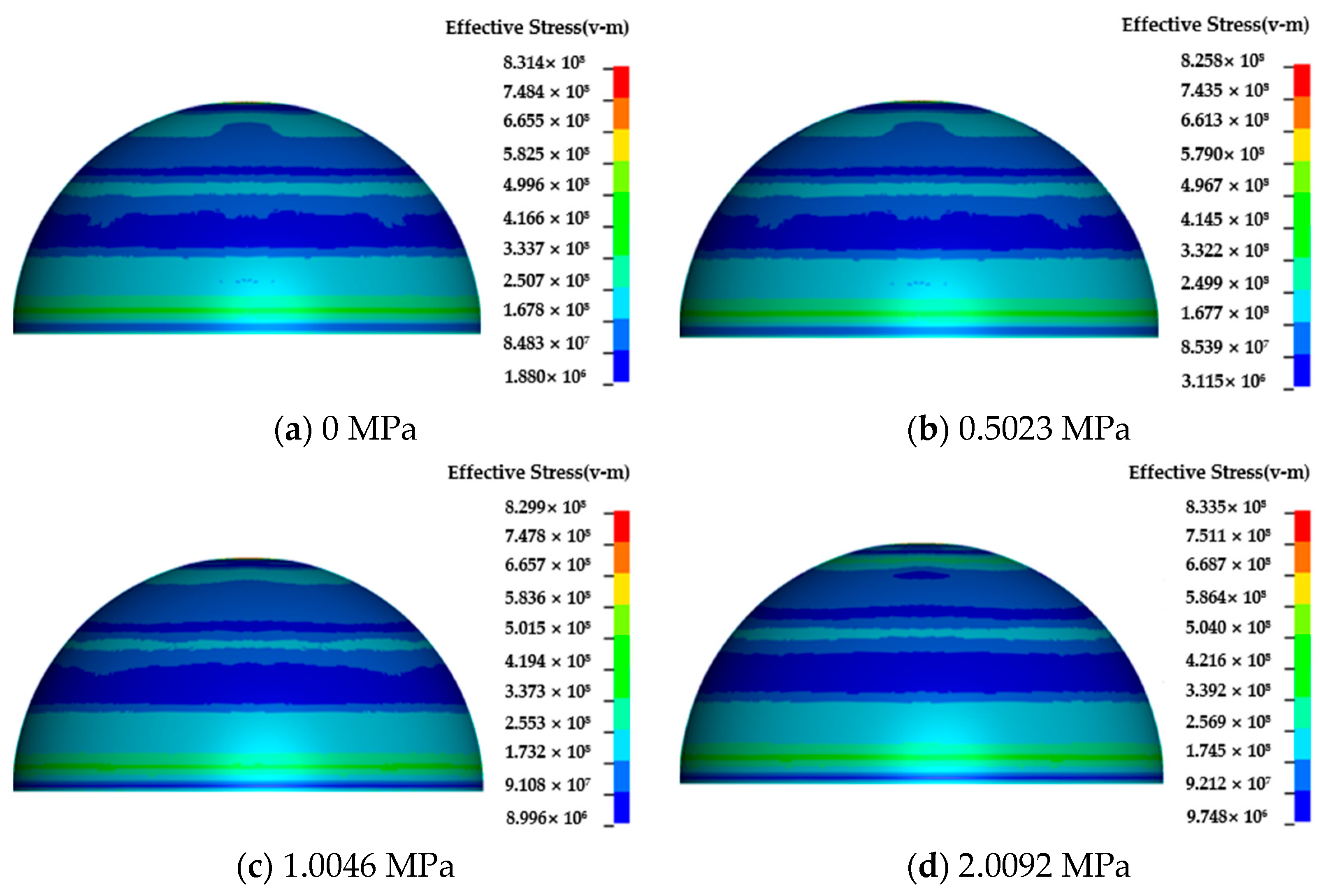

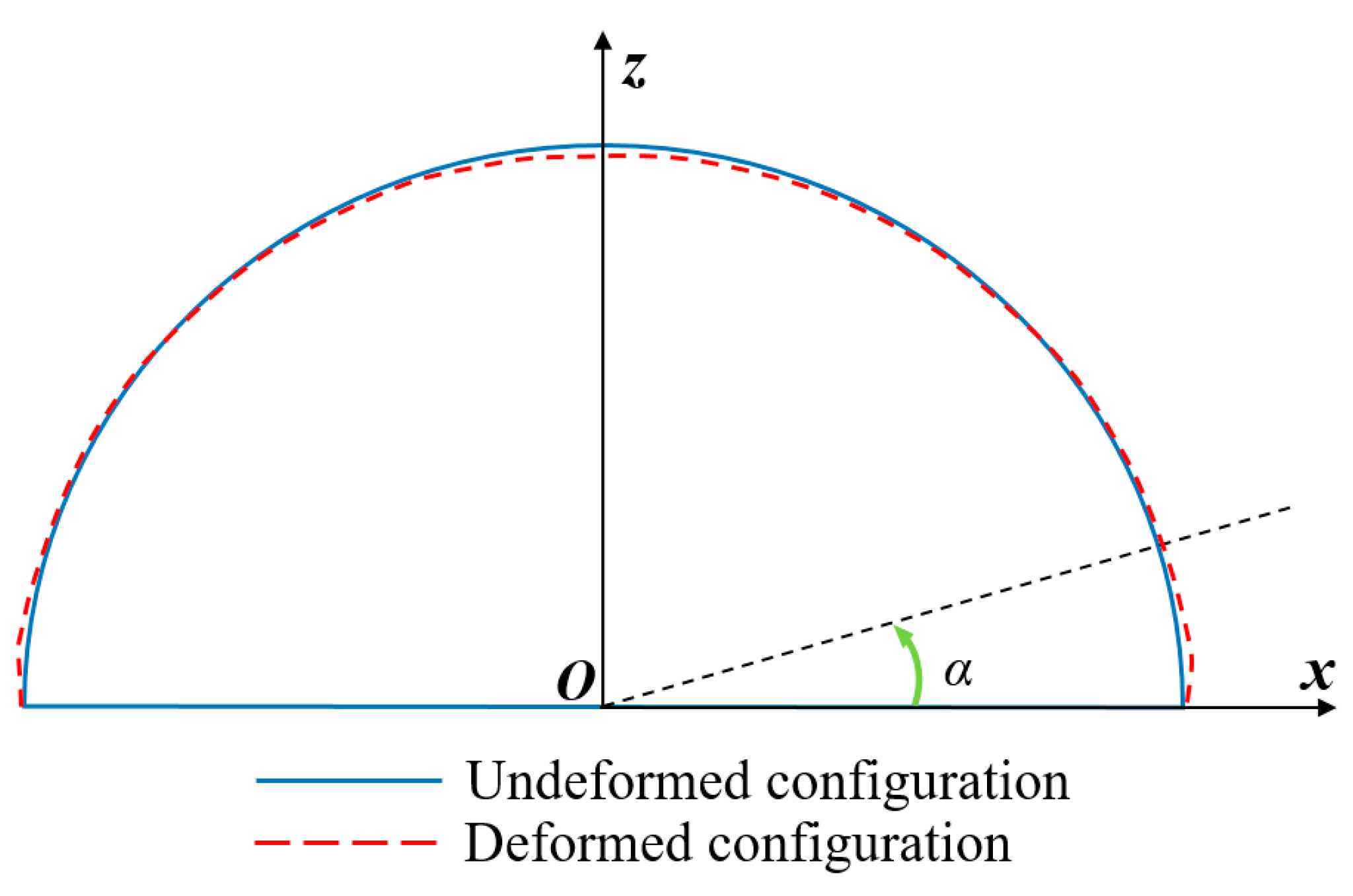
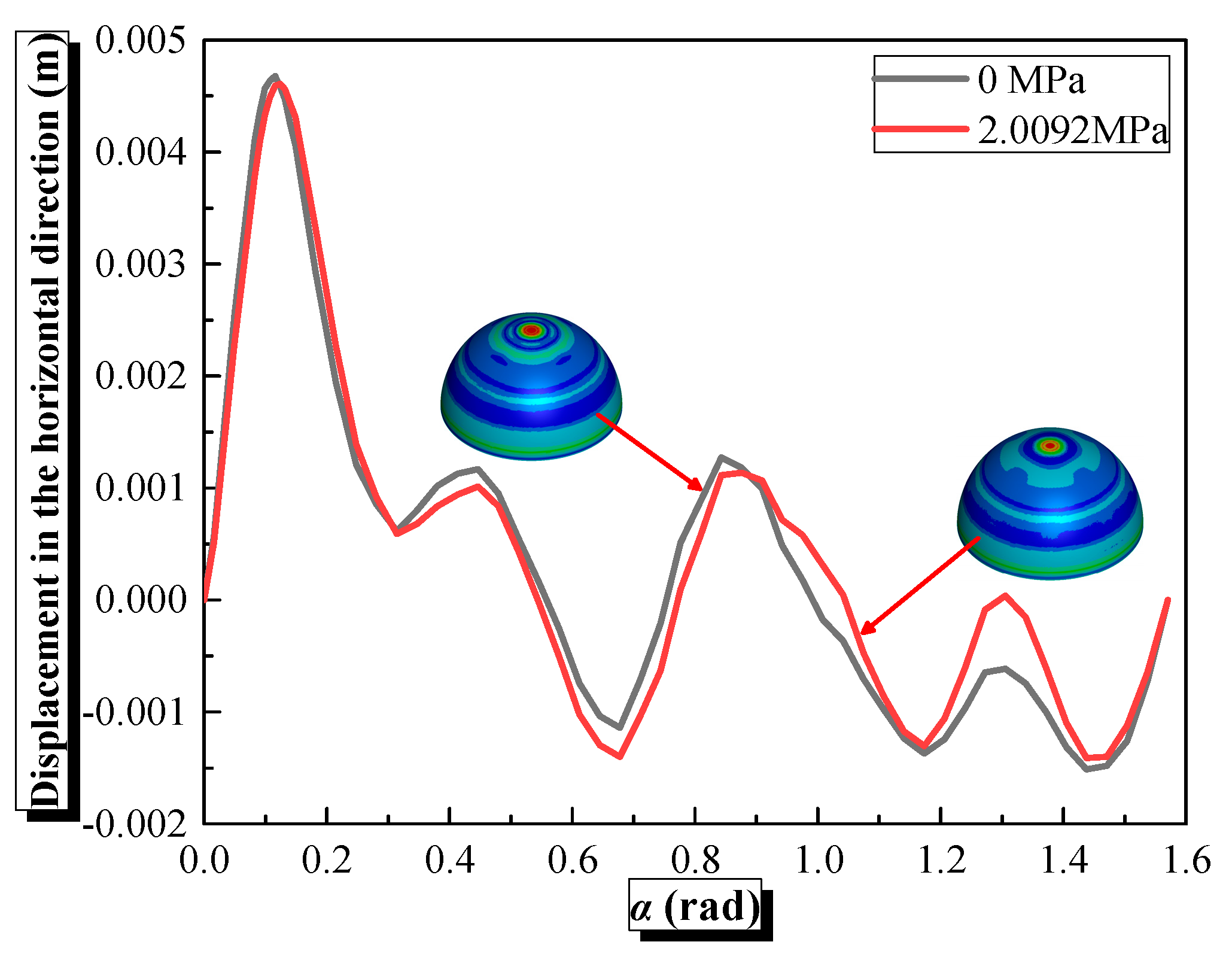


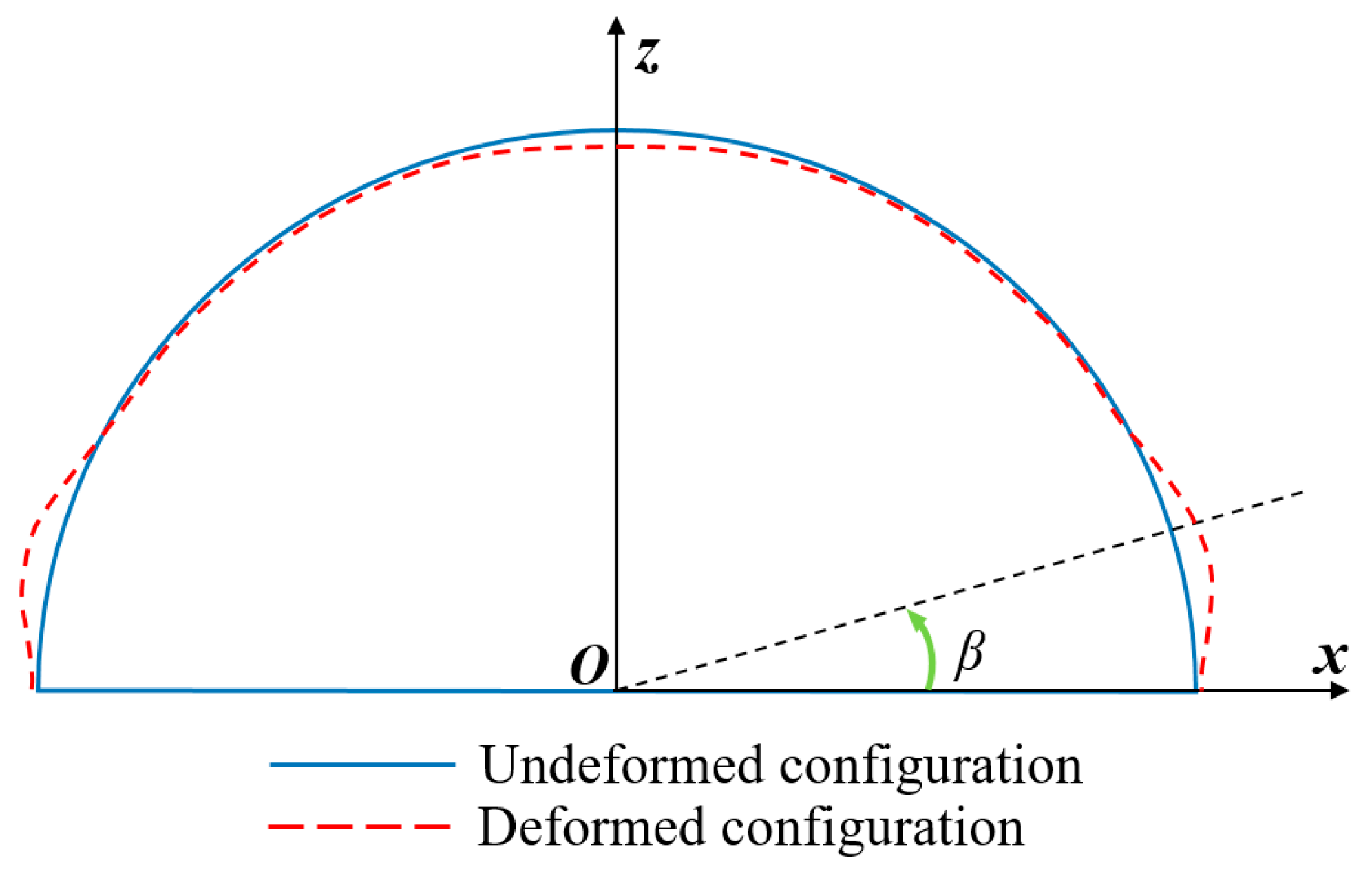





| A/GPa | B/GPa | R1 | ρ/(kg∙m−3) | D/(m∙s−1) | Pcj/GPa | R2 | ω | E0/GPa |
|---|---|---|---|---|---|---|---|---|
| 373.77 | 3.747 | 4.15 | 1630 | 6930 | 21 | 0.9 | 0.35 | 6 |
| ρ/(kg∙m−3) | S1 | γ0 | C/(m∙s−1) | S2 | S3 | a |
|---|---|---|---|---|---|---|
| 1000 | 1.921 | 0.35 | 1647 | −0.096 | 0 | 0 |
| ρ/(kg∙m−3) | E0 | C0–C3 | C4, C5 | C6 | V0 |
|---|---|---|---|---|---|
| 1.25 | 2.53 × 105 | 0 | 0.4 | 0 | 1.0 |
| A/(MPa) | B/(MPa) | C | n | m |
|---|---|---|---|---|
| 722 | 400 | 0.021 | 0.57 | - |
| Explosive Distances (m) | Simulated Pm (MPa) | Theoretical Pm (MPa) | Deviation (%) | ||||
|---|---|---|---|---|---|---|---|
| 0.12 m | 0.13 m | 0.14 m | 0.12 m | 0.13 m | 0.14 m | ||
| 3 | 165.00 | 161.00 | 160.00 | 174.67 | −5.53 | −7.82 | −8.40 |
| 4 | 108.00 | 107.00 | 104.00 | 113.45 | −4.80 | −5.68 | −8.33 |
| 5 | 80.30 | 78.20 | 76.50 | 81.18 | −1.08 | −3.67 | −5.76 |
| 6 | 63.80 | 62.60 | 60.80 | 61.75 | 3.31 | 1.37 | −1.54 |
| 7 | 50.90 | 50.10 | 49.60 | 49.01 | 3.87 | 2.23 | 1.21% |
| 8 | 43.10 | 42.00 | 41.80 | 40.11 | 7.45 | 4.71 | 4.21 |
| 9 | 36.90 | 36.40 | 35.70 | 33.61 | 9.77 | 8.29 | 6.20 |
Disclaimer/Publisher’s Note: The statements, opinions and data contained in all publications are solely those of the individual author(s) and contributor(s) and not of MDPI and/or the editor(s). MDPI and/or the editor(s) disclaim responsibility for any injury to people or property resulting from any ideas, methods, instructions or products referred to in the content. |
© 2025 by the authors. Licensee MDPI, Basel, Switzerland. This article is an open access article distributed under the terms and conditions of the Creative Commons Attribution (CC BY) license (https://creativecommons.org/licenses/by/4.0/).
Share and Cite
Lin, F.; Zhou, X.; Xiao, L.; Liu, Z.; Liu, C. Dynamic Response of Bottom-Sitting Steel Shell Structures Subjected to Underwater Shock Waves. Infrastructures 2025, 10, 130. https://doi.org/10.3390/infrastructures10060130
Lin F, Zhou X, Xiao L, Liu Z, Liu C. Dynamic Response of Bottom-Sitting Steel Shell Structures Subjected to Underwater Shock Waves. Infrastructures. 2025; 10(6):130. https://doi.org/10.3390/infrastructures10060130
Chicago/Turabian StyleLin, Fantong, Xianxiang Zhou, Lan Xiao, Ziye Liu, and Chaojia Liu. 2025. "Dynamic Response of Bottom-Sitting Steel Shell Structures Subjected to Underwater Shock Waves" Infrastructures 10, no. 6: 130. https://doi.org/10.3390/infrastructures10060130
APA StyleLin, F., Zhou, X., Xiao, L., Liu, Z., & Liu, C. (2025). Dynamic Response of Bottom-Sitting Steel Shell Structures Subjected to Underwater Shock Waves. Infrastructures, 10(6), 130. https://doi.org/10.3390/infrastructures10060130





